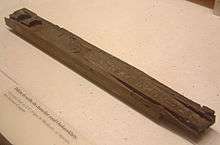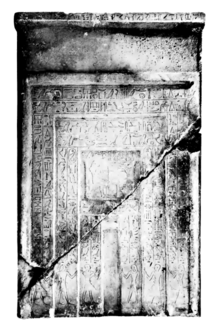Merikare
| Merikare | |
|---|---|
| Merykare, Merykara | |
 Scribe palette of the chancellor Orkaukhety, with the cartouche of Merikare. | |
| Pharaoh | |
| Reign | c. 2075–2040 BC (10th Dynasty) |
| Predecessor | Wahkare Khety ? |
| Successor | possibly an unnamed ephemeral successor,[1] then Mentuhotep II (11th Dynasty) |
|
| |
| Father | Wahkare Khety ? |
| Died | around 2040 BCE |
| Burial | Pyramid of Merikare |
Merikare (also Merykare and Merykara) was an ancient Egyptian pharaoh of the 10th Dynasty who lived towards the end of the First Intermediate Period. His name cannot be recognized in the Turin King List; also his dates are uncertain.
Reign
According to many scholars, he ruled at the end of the 10th Dynasty[4][5][6][2][7] following his father's long reign in his middle-age. The identity of his predecessor (the so-called "Khety III" who was the purported author of the Teaching for King Merikare) is still a question of debate among Egyptologists. Some scholars tend to identify Merikare's predecessor with Wahkare Khety.[8][6][7] These sebayt ("teachings", in ancient Egyptian) – possibly composed under the reign of Merikare himself and fictitiously attributed to his father – are a collection of precepts for good governance. The text also mentions the eastern borders, recently secured but still in need of the king's attention.[9] In the text, Merikare's unnamed father mentions having sacked Thinis, but he advises Merikare to deal more leniently with the troublesome Upper Egyptian realms.[8]
Once crowned, around 2075 BCE,[10] Merikare wisely resigned himself to the existence of two separate kingdoms (the Herakleopolite and the Theban ones) and tried to maintain the policy of peaceful coexistence achieved by his father.[8] It seems that the period of peace brought a certain amount of prosperity to Merikare's realm.[7] Some time later, the pharaoh himself was forced to sail up the Nile with his court on a great fleet. Once he reached Asyut, the king installed the loyalist nomarch Khety II, who succeeded his deceased father Tefibi;[8] he also made restorations at the local temple of Wepwawet. After that, Merikare advanced farther upstream to the town of Shashotep, likely to quell a revolt, and at the same time as a show of force to the turbulent southern border areas.[11]
Merikare died in c. 2040 BCE, a few months before the fall of Herakleopolis. Thus, the final defeat by the Thebans, led by Mentuhotep II of the 11th Dynasty, was likely inflicted upon an ephemeral, unnamed successor.[1]
Burial

Many sources suggest that Merikare was buried in a yet-undiscovered pyramid in Saqqara, called Flourishing are the Abodes of Merikare, that had to be near to the pyramid of Teti of the 6th Dynasty.[1] The titles of the officials involved in its construction are documented, as his funerary cult endured into the 12th Dynasty; in fact, Merikare's cartouche appears on the stelae of at least four priests who were responsible for the funerary cult of Teti and Merikare during the Middle Kingdom.[12] They include Gemniemhat who also held other important positions.
Attestations
Merikare is the most attested among the Herakleopolite rulers. His name appears on:
- the Teaching for King Merikare;
- a wooden scribe palette belonging to the chancellor Orkaukhety, found in a tomb near Asyut (along with a brazier dedicated to Meryibre Khety) and now at the Louvre;[4]
- the inscriptions from the tomb of the nomarch Khety II, in Asyut;[4]
- nine steles attesting the existence of his pyramid and his funerary cult in Saqqara.[3]
Hypothesis of an earlier reign
In 2003 the Egyptologist Arkadi F. Demidchik suggested that Merikare's placement within the dynasty should be reconsidered. According to him, if Merikare reigned during the campaign led by Mentuhotep II then the former's pyramid and its cult couldn't have survived the Theban conquest; again, Merikare likely would not be able to obtain granite from the South as mentioned in the Teachings. Demidchik also argued that the battles for Thinis mentioned by Tefibi and Merikare were the same fought – in the opposite front – by the Theban ruler Wahankh Intef II, thus suggesting that Merikare's reign should be placed some decades earlier than usually thought, when the 10th Dynasty's power was at its peak.[3]
References
- 1 2 3 William C. Hayes, in The Cambridge Ancient History, vol 1, part 2, 1971 (2008), Cambridge University Press, ISBN 0-521-077915, pp. 467–78.
- 1 2 Jürgen von Beckerath, Handbuch der Ägyptischen Königsnamen, 2nd edition, Mainz, 1999, p. 74.
- 1 2 3 Arkadi F. Demidchik (2003), "The reign of Merikare Khety", Göttinger Miszellen 192, pp. 25–36.
- 1 2 3 Flinders Petrie, A History of Egypt, from the Earliest Times to the XVIth Dynasty (1897), pp. 115-16.
- ↑ William C. Hayes, op. cit. p. 996.
- 1 2 Nicolas Grimal, A History of Ancient Egypt, Oxford, Blackwell Books, 1992, pp. 141–45.
- 1 2 3 Michael Rice, Who is who in Ancient Egypt, 1999 (2004), Routledge, London, ISBN 0-203-44328-4, p. 113.
- 1 2 3 4 William C. Hayes, op. cit. p. 466–67.
- ↑ William C. Hayes, op. cit. p. 237.
- ↑ Miriam Lichtheim, Ancient Egyptian Literature, vol. 2. pp. 97-109. University of California Press 1980, ISBN 0-520-02899-6, p. 97.
- ↑ Alan Gardiner, Egypt of the Pharaohs. An introduction, Oxford University Press, 1961, p. 113.
- ↑ James Edward Quibell, Excavations at Saqqara (1905-1906), Le Caire, Impr. de l'Institut français d'archéologie orientale (1907), p. 20 ff; pl. XIII, XV.
Further reading
| Wikimedia Commons has media related to Merikare. |
- Wolfgang Kosack; Berliner Hefte zur ägyptischen Literatur 1 - 12: Teil I. 1 - 6/ Teil II. 7 - 12 (2 Bände). Paralleltexte in Hieroglyphen mit Einführungen und Übersetzung. Heft 8: Die Lehre für König Merikarê. Verlag Christoph Brunner, Basel 2015. ISBN 978-3-906206-11-0.